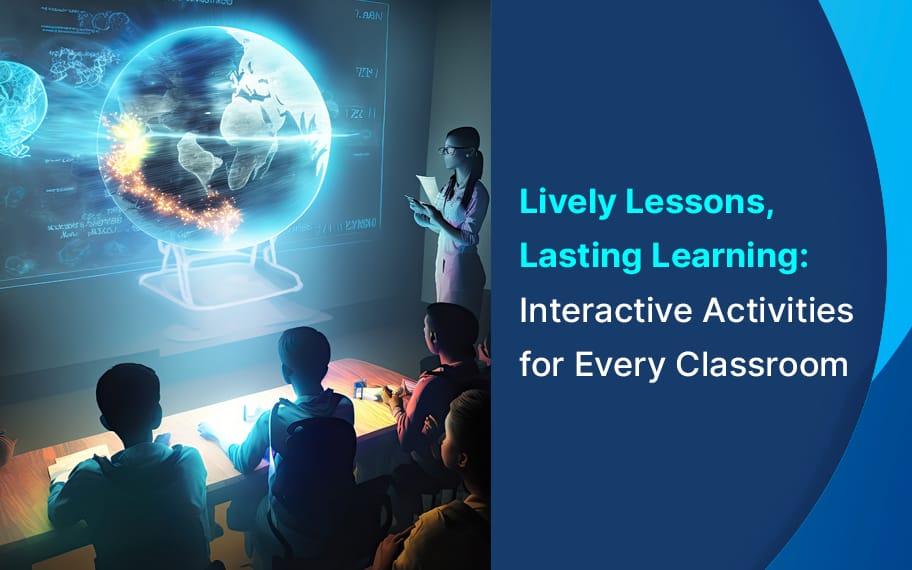Let's face it. One of the hardest tasks of a teacher is maintaining student decorum and attention in the classroom. Especially for younger age groups, keeping productive student engagement high can be a hassle. Unfortunately, we simply can't do without it. So what's the solution? Keep reading today's blog to learn more about how to create interactive learning environments for your classroom.
What is the definition of student engagement?
In an academic sense student engagement refers to the act of being involved in the lesson with heightened concentration and interaction. It could also refer to the commitment they show towards learning within the classroom.
Why are interactive teaching methods important in the classroom?
The role of a teacher is to not just provide academic education to students. Rather, they need to ensure that students understand the lessons being taught and have fun doing so as well. This is where student engagement comes in. Building an interactive classroom environment has several benefits for learners and educators alike, such as:
- It motivates students to put effort into learning and helps them build a long-term positive relationship towards studying.
- Interactive learning makes students a part of the education process thus encouraging retention and real-world application of concepts taught in the classroom.
- By encouraging student engagement, teachers promote critical thinking and creative expression rather than only rote learning methods.
- Teachers who stimulate student engagement can benefit from immediate feedback as reflection and review are common tools used in interactive learning environments.
- Teachers can offer a personalised learning experience to each student- whether they be a visual learner, an auditory learner or a hands-on learner. This ensures a level playing ground for all students, that offers each of them a chance at understanding and imbibing the lesson.

What are the most effective interactive teaching methods?
Encourage physical activity
Often students find it difficult to sit still for long durations. When forced to keep still their minds begin to wander and take away their focus from the lesson. To avoid such an occurrence teachers should encourage movement within the classroom. For example, students can be asked to make groups and work on an assignment.
Get familiar with gamification
Gamification is the process of making the learning experience more fun by emulating the challenge-and-reward format of games. This tip is especially for those classrooms that have a smart board otherwise known as a digital whiteboard. However, gamification can still be carried out with the help of tools such as "good behaviour" stickers or intra-class quizzes.
Show interest in their hobbies
Young students often look up to their teachers not just as academic figures but also as role models. Naturally, they seek validation and encouragement from their teachers. You can try asking about their weekend and keeping notes of their hobbies to show interest and build a one-on-one connection with students. Not only does this make the student more inclined to pay attention in your classroom, but you can also reference a particular hobby or interest to generate passion for the topic.
Explain the learning goals
Researchers from across the globe have stated that students can become more efficient learners when they know exactly where the lesson is headed and what they are expected to retain from it. Discussing lesson plans within the classroom creates effective interactive learning environments for students of all age groups and qualifications. Moreover, having access to the lesson plan helps students follow what is being taught without getting overwhelmed with extensive concepts.
Choose time to reflect and remember
At the beginning of a new lesson ask students what they remember about the topic from the last class. Not only does this help jog the student's memory but also helps the teacher to identify which points of the last lesson need to be repeated. This ensures that a new topic is begun only after a strong foundation of what was taught before.
Have transparent lines of communication
One of the most common roadblocks to achieving active participation in the classroom is a lack of communication between the teachers and the students. The authoritarian position of the farmer can make student engagement a secondary objective. Having open lines of communication can be especially beneficial for classrooms using the lecture method of teaching.
At the end of the day the person who best knows their classroom is the teacher. Try out this template for interactive teaching methods with examples best suited for your class. Happy teaching!
With Teachmint Interactive Flat Panels, Enhance the teaching and learning experience.




